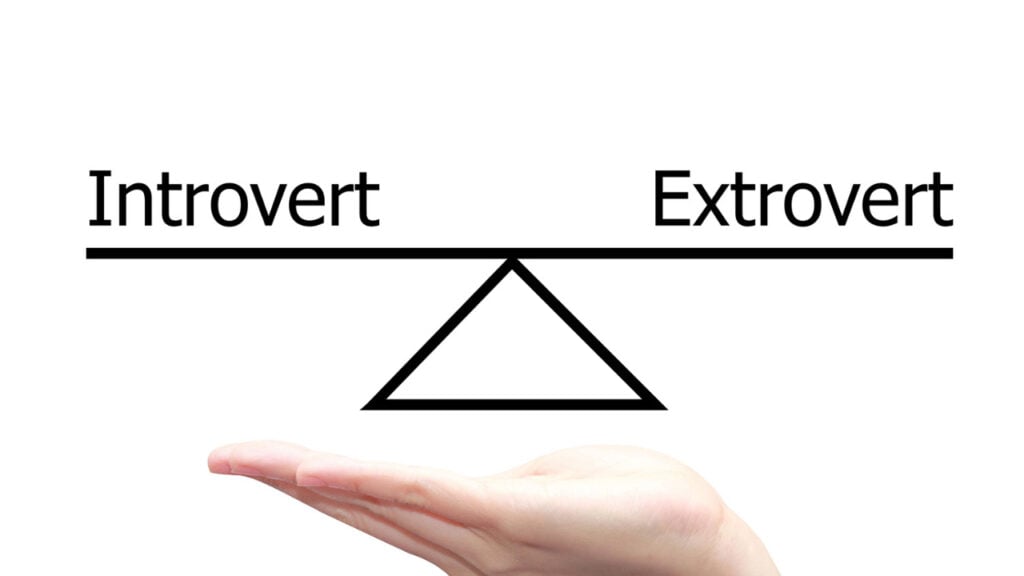On This Page:
An omnivert is an individual that fits into both extremes of the extroversion-introversion personality spectrum as defined by the Myers-Briggs Type Indicator (MBTI).
Rather than being an extrovert, an introvert, or somewhere in between, an omnivert can be both of these personalities at various times.
Omniverts will move from either extreme depending on the context of the social situation. They approach each personality with full force as if they were solely an extrovert or an introvert.
An omnivert might be hard to spot initially, as they tend to react entirely differently from how they may have presented themselves in previous situations. Moreover, omniverts can hold all of the characteristics of extroverts and introverts.
They can be social, quiet, spontaneous, and pensive. However, they do not show these qualities simultaneously, meaning that when they feel more extroverted and social, they will fail to show any indication of having their introverted characteristics.

Omnivert Personality Signs
Leaning from One Extreme to Another
An omnivert is most easily recognizable by their tendency to change their moods or personalities quickly. Since omniverts can comfortably jump around the personality spectrum, their behavior is often inconsistent and varied.
Others around omniverts might view this sharp contrast in behavior as erratic or unreliable.
Omniverts will also tend to oscillate between behaviors that highlight their extroversion or introversion. For example, when meeting people, an omnivert has the potential to be highly social.
They may talk to others, be unafraid to get to know strangers, and enjoy their time in the spotlight. However, in another situation, meeting people might put too much of a strain on their introverted personality.
In this scenario, omniverts might avoid uncomfortable small talk, act more reserved, and need to recharge their social battery.
Displaying Different Personality Traits with Different People
Since omniverts can switch from behaving as an extrovert to an introvert, they often portray conflicting personalities to different people.
This change of personality traits often depends on the characteristics of the person they are interacting with and what the situation may require of them.
When faced with a group of more introverted people, omniverts may display extroverted traits. They might facilitate more of the group’s conversation and attempt to give the team a more positive outlook.
When an omnivert encounters people who are outgoing extroverts, they might feel as though they are overextended with the social interaction and crave quality time to themselves.
Variations in Mood
Omniverts will often come across as temperamental to those around them. Since omniverts rapidly swap their personalities, it is hard to predict how they may behave or react to certain situations. This might make it challenging for omniverts to understand their feelings.
Their ability to quickly change moods might connect to their tendency to jump between personality traits. As omniverts change their traits, their mood alters as well.
For example, an omnivert’s mood might be more somber and contemplative, but then they will experience a sudden burst of energy that may have them come across as vibrant and giddy.
Enjoying Alone Time
Similar to how introverts need their time to recharge alone, extroverts also enjoy alone time. In this time alone, they are introspective and reserved, content with their inner minds.
Though omniverts are extroverted and can love social settings, their solitude is important to maintaining their omnivert personalities.
Since omniverts’ personalities jump between the two extremes, this extra need for rest might be connected to the need for recuperation following shifts. However, there is little research to support this theory.
Variations in MBTI Scores
An omnivert might find that their personality types tests are not consistent. From one day to the next, their MBTI might show them to be introverted. The next time they take the test, they might reflect a completely different personality type.
The score difference is primarily due to the omnivert’s tendency to alternate between the two personality traits. However, this variation can be confusing for omniverts who are unfamiliar with what it means to be an omnivert.
Moreover, the MBTI scores completely fail to describe the entirety of an omnivert’s personality accurately.
Since the current MBTI testing system only measures levels of introversion and extroversion and not the presence of both, likely, the full scope of an omniverts’ extroversion will not be reflected in their scores.
Omniverts vs Ambiverts
Similarities
Both omniverts and ambiverts are similar in the sense that they do not fit directly into either of the extremes of the personality spectrum. They are not introverts or extroverts but a combination of both personality types.
As a result, omniverts’ and ambiverts’ personality types are very adaptable. Possessing both qualities of extroverts and introverts, ambiverts and omniverts alike hold many advantageous qualities.
For example, the setting may call for quiet and introspective behavior during a test. In contrast, another situation, like being the soccer team captain, might require more leadership skills.
Omniverts and ambiverts can easily meet the necessary traits to succeed in both situations. However, when given the same situations, a pure introvert or extrovert may have difficulty approaching tasks outside their comfort zone.
Moreover, omniverts and ambiverts have enough flexibility in the spectrum to adjust their behavior to fit the appropriate social context. This ability also makes them harder to distinguish from someone that fits into the box of introvert or extrovert.
Differences
An omnivert and an ambivert are not the same personality type, even though these terms are often used interchangeably. The two personalities have many similarities as they exist outside the extrovert-introvert spectrum.
However, they are different as omniverts can jump between personalities while ambiverts sit comfortably in the space between the middle.
Omniverts can portray specific characteristics for extroverts and introverts alike as if they only have that personality. In various situations, omniverts will completely shift their behavior.
Omniverts quickly flip from one extreme of the personality spectrum to the other. The intensity of their character traits makes them unpredictable.
They can act extremely extroverted and give speeches without a problem one day. However, the next day, they may act more introverted and avoid engaging in conversations with others.
In contrast, ambiverts have the qualities of both extroverts and introverts, but their personalities incorporate a little bit of both to form a character more concrete. In their social situations, they can act more introverted or extroverted depending on the context, but they still tend to lean toward a particular personality type.
Ambiverts are more stable in their behavior than omniverts. Their personality will only partially shift when they enter a new situation.
For example, when it comes to public speaking, they will feel social enough to speak in front of others confidently. However, they may have anxiety about the applause and praise they receive immediately after.
| Ambivert | Omnivert | |
|---|---|---|
| Definition | A person who exhibits qualities of both introversion and extroversion, and can flip into either depending on their mood, context, and goals. | A person who can feel intensely introverted or extroverted in different situations, with preferences changing frequently and drastically. |
| Socializing | Can be comfortable in social situations but also need time alone. Their social behavior may lean more towards either extroversion or introversion, depending on the situation. | Can swing from being highly social to needing complete solitude. The intensity of extroversion or introversion can be higher compared to ambiverts. |
| Energy recharge | Recharge their energy with a balance of social interaction and alone time. | Recharge can depend intensely on either being alone or being with others, depending on their current state. |
| Energy recharge | Recharge can depend intensely on being alone or with others, depending on their current state. | Recharge can depend intensely on being alone or with others, depending on their current state. |
Frequently Asked Questions
Are omniverts a rare personality type?
There is currently limited research on omniverts as a whole. Due to the lack of studies and academic articles on omniverts, it is nearly impossible to determine how rare the personality type is.
However, the absence of data itself may highlight that omniverts are likely to be the minority of individuals. Further analysis is necessary to learn more about omniverts, as well as the exact percentages or quantities of individuals who may have the ability to jump between the extroverted and introverted characteristics.
Can someone truly be one personality trait or another?
Individuals can indeed be one personality trait or another. Your personality is a unique part of who you are and how you interact with the world. In fact, some studies have shown that personality traits might be linked to our genetic makeup (Smeland et al., 2017).
An individual’s place on the personality spectrum is crucial to their worldview and possibly a part of their DNA. Still, it is essential to understand that individuals can exhibit varied levels of introversion and extroversion in their everyday interactions.
Though someone may not exhibit every personality trait associated with their place on the spectrum, a person can still exhibit characteristics and extroversion levels closely associated with a particular personality.
Are omniverts real?
Some may question the validity of omniverts as they exist outside the Myers-Briggs Test Indicator (MBTI) realm.
It is true that the original MBTI solely includes extroversion and introversion in its scale. However, the goal of the MBTI is to learn more about yourself and how you relate to your surroundings.
That said, not everyone relates to the confines of an extroverted or introverted personality type.
There is room for variance when it comes to personality, and omniverts (and ambiverts) are an example of a real character trait for those individuals that identify with it.
References
Cherry, K. (2022, July 28). Myers-Briggs Type Indicator: The 16 personality types. Verywell Mind. Retrieved January 6, 2023, from https://www.verywellmind.com/the-myers-briggs-type-indicator-2795583
Farooq, B. (2022, June 14). Omnivert vs Ambivert Differences: Identification Key Points. She Began. Retrieved January 12, 2023, from https://shebegan.com/omnivert-vs-ambivert-differences-identification-key-points/
Gaynor, G. J. (2022, October 17). What’s an Omnivert? How to Spot one Every Time. Face Dragons. Retrieved January 10, 2023, from https://facedragons.com/lifestyle/whats-an-omnivert/#:~:text=One%20thing%20is%20sure%2C%20though,bounces%20from%20the%20two%20extremes.
Goldman, R. (n.d.). Are you an ambivert? Meaning, Characteristics, Benefits, and more. Healthline. Retrieved January 10, 2023, from https://www.healthline.com/health/ambivert#1
Harris, E. (2022, August 6). What’s the Difference Between an Ambivert and an Omnivert? Truity. Retrieved January 10, 2023, from https://www.truity.com/blog/whats-difference-between-ambivert-and-omnivert
Nickerson, C. (2022, June 14). What is an Ambivert? An In-Depth Definition and Guide. Simply Psychology. www.simplypsychology.org/ambivert.html
Raypole, C. (2022, July 5). Extroverts, Introverts, and Everything in Between. Healthline. Retrieved January 30, 2023, from https://www.healthline.com/health/extrovert-vs-introvert#ambivert-signs
Smeland, Wang, Y., Lo, M.-T., Li, W., Frei, O., Witoelar, A., Tesli, M., Hinds, D. A., Tung, J. Y., Djurovic, S., Chen, C.-H., Dale, A. M., & Andreassen, O. A. (2017). Identification of genetic loci shared between schizophrenia and the Big Five personality traits. Scientific Reports, 7(1), 2222–2229. https://doi.org/10.1038/s41598-017-02346-3


